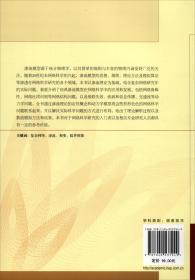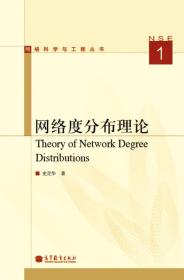
网络科学与工程丛书:复杂网络传播动力学 模型、方法与稳定性分析(英文版)
书角有磨损,内页干净
¥ 49 6.2折 ¥ 79 九品
仅1件
作者傅新楚、[澳]斯摩尔(Michael Small)、陈关荣 著
出版社高等教育出版社
出版时间2014-02
版次1
装帧精装
货号B8-6B
上书时间2024-07-18
- 店主推荐
- 最新上架
商品详情
- 品相描述:九品
图书标准信息
- 作者 傅新楚、[澳]斯摩尔(Michael Small)、陈关荣 著
- 出版社 高等教育出版社
- 出版时间 2014-02
- 版次 1
- ISBN 9787040307177
- 定价 79.00元
- 装帧 精装
- 开本 16开
- 纸张 胶版纸
- 页数 314页
- 字数 480千字
- 正文语种 英语
- 丛书 网络科学与工程丛书
- 【内容简介】
-
《网络科学与工程丛书·复杂网络传播动力学:模型、方法与稳定性分析(英文版)》较全面介绍了复杂网络传播动力学的研究结果与最新进展,包括三位作者的近期研究成果。主要内容包括各种“仓室”模型及有关的主要结果;复杂网络上流行病的网络建模、数值模拟、疾病控制与风险评估;流行病阈值的几种主要求法;疾病的控制与免疫方法,各种免疫策略的比较;人类意识在疾病传播与控制中的独特作用;在传播媒介作用下非齐次网络上流行病动力学的性质;几种典型网络传播模型的全局稳定性;网络同步动力学与流行病传播动力学之间的自适应演化关系;信息、舆情、谣言等在因特网及社会网络中的传播特性;信启、传播与流行病传播之间的异同等。
《网络科学与工程丛书·复杂网络传播动力学:模型、方法与稳定性分析(英文版)》可作为高等院校应用数学、生物数学、计算机科学与技术等专业相关课程的教学参考书,也可供从事动力系统、网络科学和复杂性科学等领域研究工作的教学科研人员参考使用。 - 【作者简介】
-
傅新楚,2001年获英国Exeter大学应用数学博士学位。1997年至2002年在英国剑桥大学、Warwick大学作高级访问学者,随后在英国Surrey大学、Exeter大学任ResearchFellow,由英国国家基金EPSRC资助研究一类不连续系统的动力学问题。2002年5月回国,在上海大学数学系工作,任教授、博士生导师。先后主持国家自然科学基金项目5项,曾参加国家“攀登计划”重大项目。
斯摩尔(MichaelSmall),西澳大利亚大学应用数学Winthrop教授,澳大利亚研究理事会未来研究员,IEEE高级会员,澳大利亚数学会会员,多家国际期刊的编委。曾在香港理T.大学电子及信息工程系做博士后并任教。在混沌、非线性时间序列建模、复杂系统等领域的基础理论及应用方面,发表约150篇期刊论文和书籍章节,约150篇会议论文,3部著作。
陈关荣,1981年获中山大学计算数学硕士学位,1987年获美国德克萨斯A&M大学应用数学博士学位。于休斯顿大学任教至2000年,现任香港城市大学电子工程系讲座教授。1996年当选为IEEEFellow。获2012年及2008年国家自然科学二等奖、2010年何梁何利奖、2011年俄罗斯欧拉奖并获俄罗斯圣彼得堡国立大学荣誉博士学位,获5项IEEE等最佳学术杂志论文奖,是国内外30多所大学的荣誉或客座教授,现任InternationalJournalofBifurcationandChaos主编。SCI他引两万多次,h指数78,被ISI评定为工程学高引用率研究人员。 - 【目录】
-
1Introduction
1.1Motivationandbackground
1.2Abriefhistoryofmathematicalepidemiology
1.2.1Compartmentalmodeling
1.2.2Epidemicmodelingoncomplexnetworks
1.3Organizationofthebook
References
2Variousepidemicmodelsoncomplexnetworks
2.1Multiplestagemodels
2.1.1Multiplesusceptibleindividuals
2.1.2Multipleinfectedindividuals
2.1.3Multiple-stagedinfectedindividuals
2.2Stagedprogressionmodels2.1Multiplestagemodels
2.1:1Multiplesusceptibleindividuals
2.1.2Multipleinfectedindividuals
2.1.3Multiple-stagedinfectedindividuals
2.2Stagedprogressionmodels
2.2.1Simple-stagedprogressionmodel
2.2.2Stagedprogressionmodelonhomogenousnetworks
2.2.3Stagedprogressionmodelonheterogenousnetworks
2.2.4Stagedprogressionmodelwithbirthanddeath
2.2.5Stagedprogressionmodelwithbirthanddeathonhomogenousnetworks
2.2.6Stagedprogressionmodelwithbirthanddeathonheterogenousnetworks
2.3StochasticSISmodel
2.3.1Ageneralconcept:Epidemicspreadingefficiency
2.4Modelswithpopulationmobility
2.4.1Epidemicspreadingwithoutmobilityofindividuals
2.4.2Spreadingofepidemicdiseasesamongdifferentcities
2.4.3Epidemicspreadingwithinandbetweencities
2.5Modelsinmeta-populations
2.5.1Modelformulation
2.6Modelswitheffectivecontacts
2.6.1Epidemicswitheffectivelyuniformcontact
2.6.2Epidemicswitheffectivecontactinhomogenousandheterogenousnetworks
2.7Modelswithtwodistinctroutes
2.8Modelswithcompetingstrains
2.8.1SISmodelwithcompetingstrains
2.8.2Remarksanddiscussions
2.9Modelswithcompetingstrainsandsaturatedinfectivity
2.9.1SISmodelwithmutationmechanism
2.9.2SISmodelwithsuper-infectionmechanism
2.10Modelswithbirthanddeathofnodesandlinks
2.11Modelsonweightednetworks
2.11.1Modelwithbirthanddeathandadaptiveweights
2.12Modelsondirectednetworks
2.13Modelsoncolorednetworks
2.13.1SISepidemicmodelsoncolorednetworks
2.13.2MicroscopicMarkov-chainanalysis
2.14Discreteepidemicmodels
2.14.1DiscreteSISmodelwithnonlinearcontagionscheme
2.14.2Discrete-timeepidemicmodelinheterogenousnetworks
2.14.3AgeneralizedmodelReferences
3Epidemicthresholdanalysis
3.1Thresholdanalysisbythedirectmethod
3.1.1Theepidemicrateisβlninsidethesamecities
3.1.1Epidemicsonhomogenousnetworks
3.1.1Epidemicsonheterogenousnetworks
3.2Epidemicspreadingefficiencythresholdandepidemicthreshold
3.2.1Thecaseofλ1≠λ2
3.2.2Thecaseofλ1≠λ2
3.2.3Epidemicthresholdinfinitepopulations
3.2.4Epidemicthresholdininfinitepopulations
3.3Epidemicthresholdsandbasicreproductionnumbers
3.3.1Thresholdfromaself-consistencyequation
3.3.2Thresholdunobtainablefromaself-consistencyequation
3.3.3ThresholdanalysisforSISmodelwithmutation
3.3.4ThresholdanalysisforSISmodelwithsuper-infection
3.3.5Epidemicthresholdsformodelsondirectednetworks
3.3.6Epidemicthresholdsontechnologicalandsocialnetworks
3.3.7Epidemicthresholdsondirectednetworkswithimmunization
3.3.8Comparisonsofepidemicthresholdsfordirectednetworkswithimmunizationdel
……
4NetworkedmodelsforSARSandavianinfluenza
5Infectivityfunctions
6SISmodelswithaninfectivemedium
7Epidemiccontrolandawareness
8Adaptivemechanismbetweendynamicsandepidemics
9Epidemiccontrolandimmunization
10Globalstabilityanalysis
11Informationdiffusionandpathogenpropagation
AppendixAProofsoftheorems
AppendixBFurtherproofsofresults
Index
相关推荐
-

网络渗流/网络科学与工程丛书
全新南京
¥ 77.22
-

网络科学与工程丛书:网络度分布理论
九品北京
¥ 22.99
-

网络科学与工程丛书:网络度分布理论
九品北京
¥ 22.51
-

网络科学与工程丛书:网络度分布理论
八五品东莞
¥ 10.20
-

网络科学与工程丛书:网络度分布理论
九品北京
¥ 22.05
-

网络科学与工程丛书:网络度分布理论
九品信阳
¥ 10.00
-

网络科学与工程丛书:网络度分布理论
八品成都
¥ 16.00
-

网络科学与工程丛书:网络度分布理论
九品襄阳
¥ 20.00
-

网络科学与工程丛书:网络度分布理论
八五品北京
¥ 5.00
-

网络科学与工程丛书:网络度分布理论
全新海口
¥ 78.00
— 没有更多了 —























以下为对购买帮助不大的评价